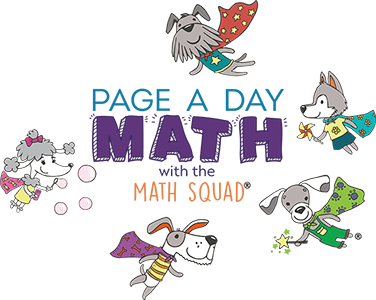
Why Didn’t Anybody Tell Me to Do Math with My Child?
As new parents, and even before our babies are born, we are told to read to them. So much research has been done on the early exposure of children to language and books showing how beneficial it is, even later in life
I had so many books, and still do, for my son and daughter. From the very beginning, I was reading to them and allowing them to explore books themselves. We went to the library and listened to other people read books. As they got older, I made sure they saw me reading my own books. We. Had. Books. Covered. So, why wasn’t I doing any math?

Why Isn’t Early Math a Priority?
There have been many studies proving the benefits of reading. Studies on early math began later. Likely due to a combination of our lives and livelihoods becoming more dependent on technology, and the realization that, compared to other countries, our students aren’t doing so well in math, more focus has now been put on studying early math education.
We’ll get into what that research tells us in a bit, but before we do, I want to dig into my own behavior as a parent to young children. Looking back, it seems so obvious to me that I should have been doing more with numbers and shapes and problem-solving. I would never have completely left reading up to someone else to teach my children. Why did I think math I should do that with math?
I don’t have a good answer to this question. Some parents tell me that they didn’t like math or weren’t good at it, but I enjoyed and excelled in math, so that’s not it. When my kids were toddlers in the grocery cart, I would literally narrate everything I was doing at the store because (a) I was sleep-deprived and needed to remind myself and (b) what a great way to teach new words. Math could have easily been a part of those grocery store trips. Counting fruit, naming their shapes, adding up vegetables in the cart—math is a part of everyday life. Maybe it’s just harder to see?
My point here is that I’m not talking about trying to explain square roots to a three-year-old. Math can easily be incorporated into your interactions with your young children, regardless of whether you enjoyed it or were good at it. And it can make a big difference later on.
What the Studies Show
Research now tells us that early math skills are not only a predictor of future success, but math is one of the best predictors there are. Kids who enter the school system with better math skills perform better and experience more success in fifth and eighth grades.
But maybe my child isn’t ready for math? Not true. Evidence suggests that early math skills, like addition and subtraction, are actually an innate ability. Babies as young as six months can tell when one item has been taken away from a pair. Young children’s brains are rapidly developing, including the “math parts,” from the get-go.
Okay, so math is important. But my child goes to preschool, so they can teach him math. You’re right, they could. But they’re not. Researchers found that children attending preschool programs for six hours a day received an average of 58 seconds of math a day. Not even a full minute of math! What’s more, it is often taught in ways that promote memorization over problem-solving and logical thought. (counting isn't really math)
What Are Other Countries Doing?
Clearly many other countries are doing something that works better than what we’re doing in the US because their children score higher in math assessments. It’s tricky to tease out exactly what is making the difference, but there are some theories.
One idea is that kids elsewhere excel in math because more of them attend preschool. Only 69 percent of four-year-olds in the US attend preschool. This number is even smaller for three-year-olds (barely 50 percent). As a comparison, 97 percent of four-year-olds in the United Kingdom attend preschool.
10 Easy Ways to Incorporate Math
The great news is that adding math to the everyday life of your young child is not difficult. Math is truly all around us. It’s really just a matter of recognizing opportunities to point it out. Here are some ideas for including “number talk” into what you are probably already doing.
- Read books that incorporate math. I’m not talking about an introduction to algebra. I mean something like The Very Hungry Caterpillar. How many apples did he eat on that day? Let’s count them! Just about any children’s picture book can be used for math. How many people do you see in this picture? How many of them have black hair?
- Baking and cooking easily lends itself to talking about math. How many teaspoons of vanilla do I need? Help me count them. We need to double this muffin recipe in order to have enough for your friends. How many cups of flour should I use?
- Measure things! Have you ever given a child a measuring tape? It will make you feel silly for buying them toys at all. They LOVE them. How long is the couch? How long is your dresser? Which is taller, your bear or your tiger?
- Any kind of building block is a great math opportunity. How many blocks do we need to make the tower as high as the table? Use patterns while you build. Point out the different shapes of the blocks.
- Mealtimes are another easy time to add in some math. How many strawberries are on your plate? Who has more crackers, you or me? How many bites do you think it’s going to take to finish your hotdog?
- Nesting toys are a good way to give kids a visual for comparing sizes. Nesting cups can be fun during bathtime. Which cup holds more water? Nesting dolls are fun, too!
- Sometimes, you just need a break. I’m a mom. I totally get it. There are some great TV shows out there that (a) focus on math, and (b) can buy you 10 minutes of alone time! Peg + Cat and Team Umizoomi are both good options. As your kids get older, Odd Squad is another great choice.
- The grocery store is chock full of math learning opportunities! How many bags do we need for our vegetables? What shape is the orange? We need four lemons — could you help me count them? How much do you think these carrots weigh?
- Stuck inside on a rainy day? Use it to your advantage and track the weather! How many days this week have been rainy? Sunny? Cloudy? What is the temperature? Is that higher or lower than yesterday?
- Do your own math out loud so that your kids can see how it’s used in real life. When you are paying for groceries, looking for a less expensive item, or figuring out how many extra chairs you need when family comes over. All of these are opportunities to show your child how important math is in our lives.
Whatever the reason other countries are excelling at math while we fall behind, the research is clear. Early math skills are an important predictor of future success, and our kids are ready for math younger than many of us thought. There are so many easy ways to consciously incorporate math into your child’s everyday activities. I just hope new parents today get the message that I didn’t—read and do math with your children!
All of our Math Kits have a 100% Satisfaction Guarantee. Give your child the start they need and the practice they need to bring out their math superpowers! Only you can do that. Don't depend solely on school to help your child learn math the way they really need to know it.
About the Author and Creator of Page A Day Math
 Janice Marks
Janice Marks
Janice began her career in education to pursue teaching pre-algebra at BASIS Tucson North, a charter school currently ranked as the sixth-best STEM school in the country by Newsweek. There she found joy in teaching math, working with parents, and inspiring children to believe in themselves and thrive. This experience, along with helping her own children succeed in math, led her to develop the Page A Day Math system.





